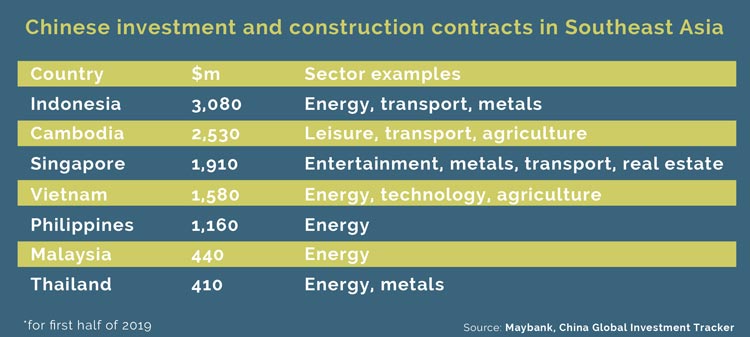Chinese Belt and Road Initiative (BRI) investment has shown signs of recovery in Southeast Asia for the first half of the year, while the trade war between the United States and China is pushing Chinese firms to relocate factories and manufacturing to Southeast Asia.
For the latest Cambodian Business news, visit Khmer Times Business
A new report from Maybank that was quoted by the The Straits Times newspaper, says that Chinese investment and construction contracts in South-east Asia nearly doubled to $11 billion (S$15.3 billion) in the first half of this year, from $5.6 billion in the second half of last year.
It says the new BRI contracts for the past six months are largely in Indonesia, Cambodia, Singapore and Vietnam and primarily for transport, agriculture and energy projects.
Debt trap worries
China Global Investment Tracker reports that Cambodia is the second-largest country in Southeast Asia after Indonesia to receive BRI investment from China in the first six months of the year, amounting to $2.5 billion.
Indonesia received $3 billion. Singapore stood in third place with the amount of investment valued at $1.9 billion. Vietnam received $1.58 billion. The Philippines got $1.16 billion. Malaysia and Thailand benefited by $440 and $410 million respectively.
Maybank reported that the BRI investment slowly increased in the second half of 2018 because of the trade war and worries of debt trap in some developing countries, including Sri Lanka, Pakistan and Malaysia.
China’s President Xi Jinping proposed the Belt and Road Initiative (BRI) in 2013 to improve connectivity and cooperation on a transcontinental scale.
Scope of initiative
The scope of the initiative is to build a series of roads, railways, ports and industrial parks linking the country to other parts of Asia, the Middle East, Africa and Europe.
Cambodia is one of the key beneficiaries of the BRI.
Participating in it has proved to be beneficial for Cambodia in terms of increasing Chinese foreign direct investment and tourism and the continuous growth of the industrial, service, agriculture and construction sectors.
Also, infrastructure development has been bolstered with the building of roads, hydropower dams, bridges, hospitals and schools of which the country is urgently in need.
While the BRI has positively contributed to Cambodia’s economic development and poverty alleviation, there is no doubt that negative aspects related to the initiative are also emerging, says Keo Piseth.
He is the director of the Centre for Sustainable Development Studies (CSDS), Asian Vision Institute (AVI).
Keo adds: “Problems related to development are not unique to Cambodia, but also in Southeast Asia and countries along the BRI corridors.
“The magnitude of the impacts vary depending on the regulations and law enforcement in each country.” The BRI follows an approach that involvesextensive consultation, joint development and shared benefits.
It advocates openness and inclusiveness. The BRI boosts Cambodia and China to raise their bilateral relationship to a new level.
Both countries are at different stages of development and have a complementary relationship with each other.
Cambodia is one of China’s oldest and closest allies. Economically, China is Cambodia’s top foreign investor, a major donor, and an increasingly important trading partner.
‘Positive impact’
Culturally, Chinese values are deeply embedded in many aspects of Cambodian society, according to Kin Phea, director-general of the Royal Academy of Cambodia’s (RAC) International Relations Institute.
Kin says that under the Cambodia-China BRI cooperation, China has invested in many large projects in the smaller country.
“BRI has a positive impact on Cambodian economic growth.
“The development of infrastructures such as roads, rails, airports, seaports, hydropower plants and special economic or industrial zones, are examples of the benefit of BRI investment in Cambodia,” he adds.
Until today there is no certain definition on the BRI investment projects in Cambodia because every Chinese company – both private and state – claim to be part of it.
Beneficial to Kingdom
As a result of the close diplomatic relationship between Cambodia and China, and the volume of Chinese investment and technical assistance to Cambodia, there is a large Chinese investment in Cambodia, but it is not necessarily a part of the BRI.
BRI investment will be beneficial for the Kingdom because it mainly focuses on the infrastructure and connectivity for trade and cultural cooperation, says Neak Chandarith, director of the Cambodia 21st Century Maritime Silk Road Research Centre in Phnom Penh and also a BRI expert.

Beneficial to Kingdom
China’s BRI is a imed at helping Chinese investors to operate businesses in other countries.
Cambodia has a good opportunity to develop its economy through that investment.
Neak agrees that it is difficult to make a judgment on which projects are related to thr BRI and which projects are not.
“Until today, we saw that the BRI investment projects in Cambodia are the Lower Se San 2 Dam, Sihanoukville Special Economic Zone, the Expressway from Phnom Penh to Sihanouk and Siem Reap International Airport,” Neak adds.
Investment projects
Mey Kalyan, the senior adviser to the Supreme National Economic Council, recognises the benefit of the infrastructure through the BRI investment projects, but is keen to make sure that they fulfill the needs of Cambodia.
Mey wants those projects to ensure transparency, efficiency, sustainability and inclusiveness.
There should also be a bilateral committee to oversee them, he adds.
“As far as we know, the BRI is focused on the infrastructure, so it is a benefit to the Kingdom,” says Mey.
However, Mey says that so far there is no exact definition or the differentiation over which projects are considered as BRI investment and those that are not.
“Some Chinese companies, barbershops or restaurants also claim that they are under the BRI,” Mey adds.
Aid and loans
China continues to draw Cambodia closer into its orbit through the provision of aid, grants, and loans, all of which appear to be condition-free.
What is more, all of the Chinese aid and loans that flow into Cambodia, more often than not, have been criticised for lack of transparency, accountability, good governance and the rule of law.
Their trade volume was valued at $5.8 billion in 2017 and China pledged to expand the trade volume to $10 billion by 2023.
The United Nation in Cambodia, however, believes that taking full advantage of the BRI requires adopting clear policies and continued analysis to assess progress in Cambodia.
This will also require recognising the role and quality of institutions and governance in driving inclusive development as advocated in the 2030 Agenda for Sustainable Development.
The UN says the BRI offers opportunities for Cambodia and the Royal Government has indicated its commitment to the project.
Now the challenge is to consider how these investments, and indeed all investments, in the country, can be made fully inclusive and sustainable so that no one is left behind.
The UN pointed this out during the third policy dialogue on April 3, 2019, that was focused on economic diversification and debt management in connection with BRI in Cambodia.
The BRI presents opportunities to address these priorities.
Debt management
At the same time, some analysts have looked with some concern at the issue of debt management associated with BRI projects in other Asian countries.
Neak, however, adds that the model of BRI investment in Cambodia is different from other affected countries.
He says that not all investment projects are provided as loans and some are private investments, particularly the model of the Built-Operate and Transfer (BOT) schemes.
Neak adds the BRI has provided huge socio-economic benefits to Cambodia to boost economic growth.
“I think BRI investment such as roads, rails, ports, airports and special economic zones are not there to create a debt trap,” he says.
“Those projects provide huge benefits for socio-economic development in the long term.”
The nature of Chinese investment anywhere is the same.
The difference in nature is very much dependent on the receiving counties in terms of their institutional capacity, leadership, governance, debt-management strategies, transparency, openness, inclusiveness and human capital, according to RAC’s director-general of International Relations Institute.
Promote transparency
Kin, therefore, says that to prevent any misperception of BRI investment projects in Cambodia, “It’s imperative for Cambodia to strengthen its institutional capacity, governance, leadership and human capital as well as improve and develop all necessary legal frameworks and policies and strictly re-enforce them in implementing BRI projects, and [there is a need] to promote transparency and openness to ensure fair bidding, responsible conducts and benefit sharing in investment projects as well as project quality.”
He acknowledges that Cambodia has yet had a proper study on how transparent, efficient and inclusive the BRI investment projects in Cambodia are at this moment.
Transparent, inclusive
But the government suggests that the economic opportunities generated from BRI investment projects are tremendous and have been made in a transparent, open and inclusive manner.
He says Chinese debt is manageable despite some people being sceptical about this initiative.
The AVI expert; however, says that the inadequate physical infrastructure, human resources and a good governance system should be in place to receive a large influx of Chinese workers for the BRI project, making it challenging for the state to effectively respond.
The most frequently resonated concern is the potential debt trap posed by the BRI.
Over this concern, the Cambodia government seems to be cautious and is paying close attention to its debt ratio.
Accordingly, the Cambodian Ministry of Economy and Finance, which regularly publishes public debt data, confirms that the Cambodia debt ratio remains within a healthy range.
The Economy and Finance Ministry (2019) stresses that “based on the international best practice, Cambodia’s public debt remains ‘sustainable’ and there is a ‘low risk’ of debt distress”.
Diversify the economy
Mey, in addition to that, says Cambodia is good at managing debt, but has to tighten its belt and diversify the economy.
“In terms of economic perspective, we need the infrastructure to connect with the whole world.
“If we do not have money, we can borrow from other countries, but we have to ensure that we can pay it back,” Mey adds.
Both Mey and Neak agree that every project could become a debt trap if the implementers do not understand the issue clearly, but they say if the institutionalisation in the country is strong, it can absorb the project to match the development’s need, so it is good for the country.
Development intervention
For the BRI projects to be effective and sustainable, integrated and cross-cutting approaches including human-resource development, public-private partnership, technology transfer, cultural preservation, market creation, scientific and innovative research and local-based (tailor-made) development intervention should be applied, says Keo.
He adds that proper governance of the BRI projects would help to minimise risks and significantly contribute to the sustainable development of Cambodia.
Both China and Cambodia need to work closer to link BRI projects with sustainable development goals.




